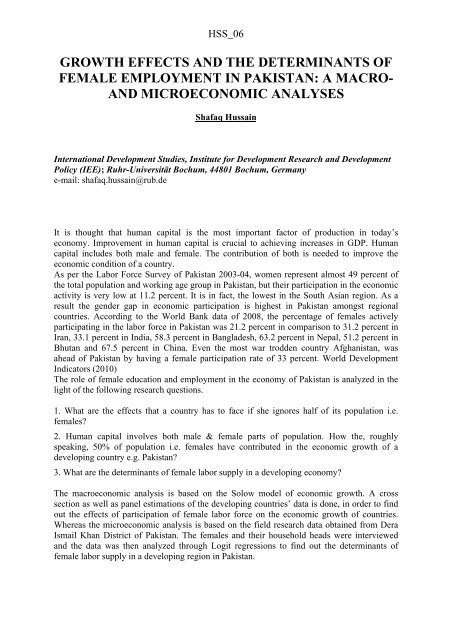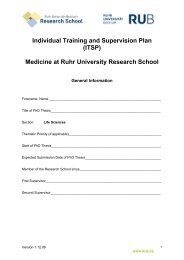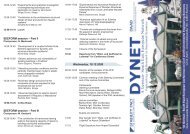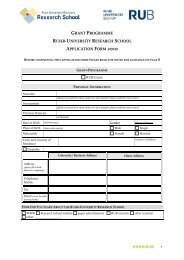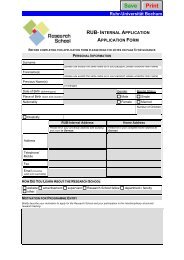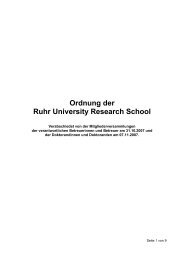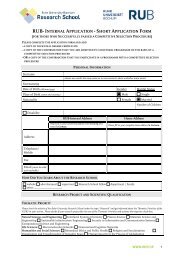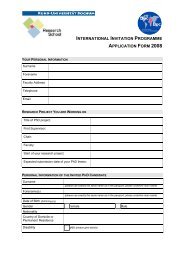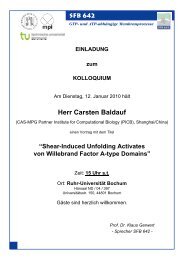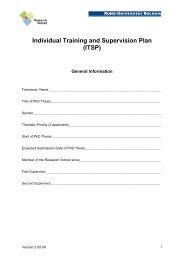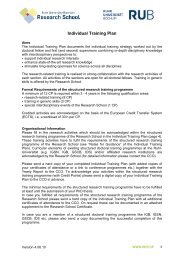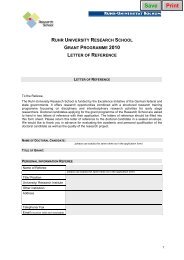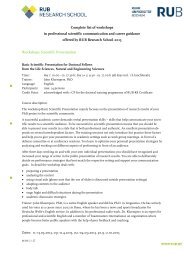Section Days abstract book 2010.indd - RUB Research School ...
Section Days abstract book 2010.indd - RUB Research School ...
Section Days abstract book 2010.indd - RUB Research School ...
Create successful ePaper yourself
Turn your PDF publications into a flip-book with our unique Google optimized e-Paper software.
HSS_06<br />
GROWTH EFFECTS AND THE DETERMINANTS OF<br />
FEMALE EMPLOYMENT IN PAKISTAN: A MACRO-<br />
AND MICROECONOMIC ANALYSES<br />
Shafaq Hussain<br />
International Development Studies, Institute for Development <strong>Research</strong> and Development<br />
Policy (IEE); Ruhr-Universität Bochum, 44801 Bochum, Germany<br />
e-mail: shafaq.hussain@rub.de<br />
It is thought that human capital is the most important factor of production in today’s<br />
economy. Improvement in human capital is crucial to achieving increases in GDP. Human<br />
capital includes both male and female. The contribution of both is needed to improve the<br />
economic condition of a country.<br />
As per the Labor Force Survey of Pakistan 2003-04, women represent almost 49 percent of<br />
the total population and working age group in Pakistan, but their participation in the economic<br />
activity is very low at 11.2 percent. It is in fact, the lowest in the South Asian region. As a<br />
result the gender gap in economic participation is highest in Pakistan amongst regional<br />
countries. According to the World Bank data of 2008, the percentage of females actively<br />
participating in the labor force in Pakistan was 21.2 percent in comparison to 31.2 percent in<br />
Iran, 33.1 percent in India, 58.3 percent in Bangladesh, 63.2 percent in Nepal, 51.2 percent in<br />
Bhutan and 67.5 percent in China. Even the most war trodden country Afghanistan, was<br />
ahead of Pakistan by having a female participation rate of 33 percent. World Development<br />
Indicators (2010)<br />
The role of female education and employment in the economy of Pakistan is analyzed in the<br />
light of the following research questions.<br />
1. What are the effects that a country has to face if she ignores half of its population i.e.<br />
females?<br />
2. Human capital involves both male & female parts of population. How the, roughly<br />
speaking, 50% of population i.e. females have contributed in the economic growth of a<br />
developing country e.g. Pakistan?<br />
3. What are the determinants of female labor supply in a developing economy?<br />
The macroeconomic analysis is based on the Solow model of economic growth. A cross<br />
section as well as panel estimations of the developing countries’ data is done, in order to find<br />
out the effects of participation of female labor force on the economic growth of countries.<br />
Whereas the microeconomic analysis is based on the field research data obtained from Dera<br />
Ismail Khan District of Pakistan. The females and their household heads were interviewed<br />
and the data was then analyzed through Logit regressions to find out the determinants of<br />
female labor supply in a developing region in Pakistan.


